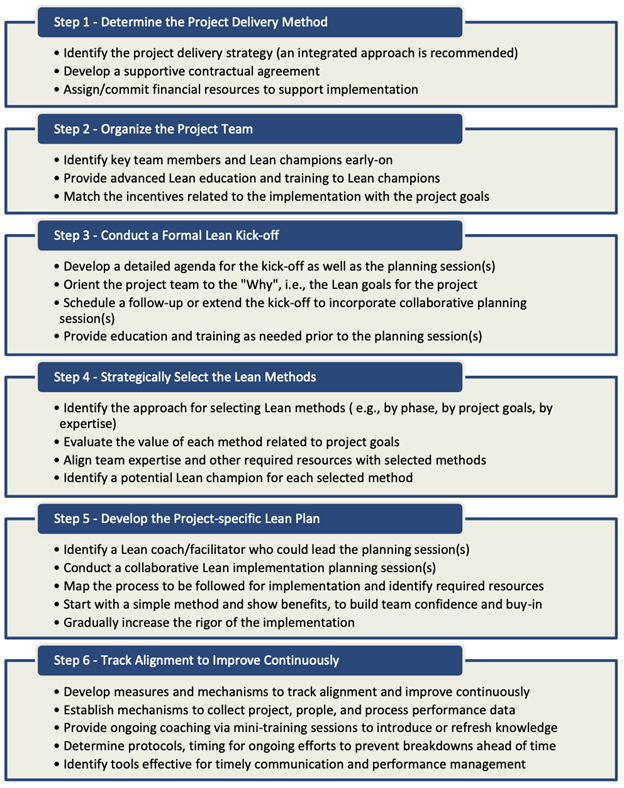Enabling Systematic Lean Implementation on Construction Projects
This blog is a summary of the article “Key Planning Steps Enabling Systematic Lean Implementation on Construction Projects” from the Lean Construction Journal. To view the full article or explore other Lean Construction Journal published research, please click here.
When considering Lean implementation on a construction project, alongside the significant benefits of partnering with Lean organizations, there is still a need to align the project team with a shared vision and strategy by developing a project-specific Lean implementation plan.
Six Key Planning Steps
We propose six steps as a standardized holistic and systematic approach to collaboratively develop this plan and derive maximum Lean advantage.
1. Determine the Project Delivery Method
The project delivery strategy serves as one of the first and most important decisions by the owner to help align the motivation of the designers and contractors toward supporting the ultimate value that the owners and clients are seeking from the project.
Although Integrated Lean Project Delivery was endorsed as being the most conducive to Lean implementation, this was not the most common option used by the industry due to a lack of sufficient Lean awareness and training. Therefore, as a first step, owners and project teams interested in Lean implementation must be proactive about making this decision and informing the larger team, communicating the plan in simple terms as part of the request for qualifications and proposals.
2. Organize the Project Team
While the exact ‘who’ may vary based on the project specifics, it is essential to identify the stakeholders and service providers who are most affected by the project, whose decisions can most influence the actual implementation needed to be engaged when planning for Lean and thus, preventing critical breakdowns.
Alongside identifying the key players, identifying champions from within the project team, who can drive the Lean implementation beyond the initial planning, further ensures success. Such individuals can be identified as volunteers or personalities who emerge as natural leaders demonstrating a Lean mindset.
Depending on the project size and complexity, having sufficient champions can make a significant impact on the overall team’s engagement and participation during the implementation. Such champions need to undergo more profound education and training to serve as internal Lean coaches on the project.
3. Conduct a Formal Lean Kick-off
Once the Lean team is organized, a formal Lean kick-off meeting must be conducted.
The Lean kick-off is conducted in various ways based on the availability of the organized project team. It can be a collaborative session or a workshop spanning an entire day or several days. Regardless of the format, the purpose is to orient the project team to the ‘why’, i.e., the Lean goals, and provide initial education and training to ensure a consistent minimum understanding and familiarity with the Lean principles and the Lean terminology. This will allow members to converse and participate in discussions successfully.
4. Strategically Select Lean Methods
After understanding the ‘Why’, project teams must shift their focus to the ‘how’ and the ‘what’.
The ‘how’ is addressed by applying strategies that support the strategic selection of Lean Construction methods aligning with the project goals.
The ‘what’ is addressed by applying strategies that support the systematic planning for implementing the selected Lean Construction methods and tracking alignment to the plan throughout implementation. This step is noted as one of the most challenging and time-consuming, but also the most crucial step in planning the details of the Lean implementation.
5. Develop a Lean Plan
Once the Lean Construction methods have been selected, the project team needs to collaboratively develop a plan for implementing them. This plan must elaborate on the details of what the implementation process looks like, including a task-level breakdown along with a list of required resources to support each task. This plan can be developed during an extended Lean kick-off meeting or as a follow-up set of multiple collaborative meetings, supplemented by various Lean training sessions to support plan development.
6. Track Alignment to Improve Continuously
Once the plan is in place, a combination of resources such as scorecards, project dashboards, and self-reported surveys can be used to track the alignment of the plan during implementation.
Conclusion
Due to the dynamic, inter-organizational, and temporary nature of typical construction project teams, every member is not at the same level in their awareness and understanding of Lean principles and methods, which makes it challenging to develop such a plan. Therefore, these six steps are intended to provide a consistent approach across a portfolio of projects.
Although the different strategies suggested within each step are not compulsory, the steps and associated strategies are somewhat essential and connected to enable a process-like flow. To learn more about this study, please refer to the research paper published in the Lean Construction Journal.
 About the Author
About the Author
 Dr. Sagata Bhawani (She/Her/Hers) is an assistant professor in construction management at California State University-Fresno. She advocates for respect for all, student-centered instruction, industry, and community-driven research, a socially just, diverse, equitable, and inclusive community, happiness, and work-life balance. Through her teaching and service, she exposes undergraduate and graduate students to the latest societal challenges that must be addressed beyond the technical and technological domains overlapping with natural and socio-economic aspects that need a systems thinking approach. Her research focuses on exploring, understanding, and integrating the different design, engineering, and construction workflows that are continuously evolving due to the rapid advancement of technology and sustainability concerning social justice, equity, diversity, and inclusion (JEDI). Before transitioning to academia, Dr. Bhawani worked in the architecture, engineering, and construction (AEC) industry, wearing many hats for ten years; working with individuals from various locations, cultural backgrounds, ethnicities, and age groups, she deeply values all forms of diversity and strives for an inclusive culture in her personal and professional life. She believes that her research work feeds into the educational leadership for students, who are the future workforce, by training them to identify where technology adoption alongside sustainability and JEDI focus can be beneficial toward making the AEC project workflows more integrated, inclusive, efficient, and holistic.
Dr. Sagata Bhawani (She/Her/Hers) is an assistant professor in construction management at California State University-Fresno. She advocates for respect for all, student-centered instruction, industry, and community-driven research, a socially just, diverse, equitable, and inclusive community, happiness, and work-life balance. Through her teaching and service, she exposes undergraduate and graduate students to the latest societal challenges that must be addressed beyond the technical and technological domains overlapping with natural and socio-economic aspects that need a systems thinking approach. Her research focuses on exploring, understanding, and integrating the different design, engineering, and construction workflows that are continuously evolving due to the rapid advancement of technology and sustainability concerning social justice, equity, diversity, and inclusion (JEDI). Before transitioning to academia, Dr. Bhawani worked in the architecture, engineering, and construction (AEC) industry, wearing many hats for ten years; working with individuals from various locations, cultural backgrounds, ethnicities, and age groups, she deeply values all forms of diversity and strives for an inclusive culture in her personal and professional life. She believes that her research work feeds into the educational leadership for students, who are the future workforce, by training them to identify where technology adoption alongside sustainability and JEDI focus can be beneficial toward making the AEC project workflows more integrated, inclusive, efficient, and holistic.
